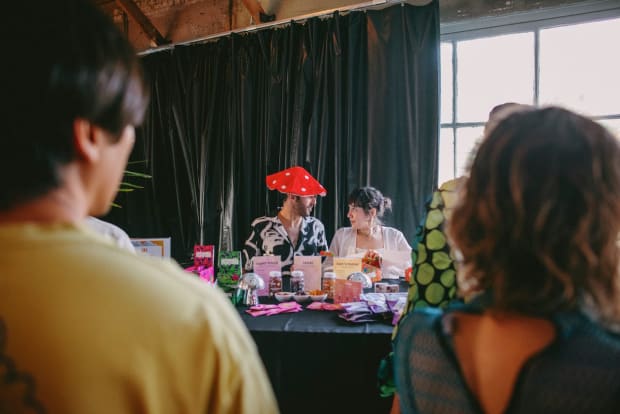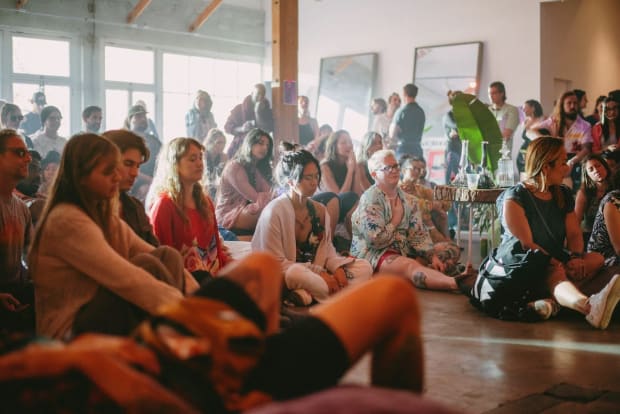In the exciting world where electronic music and psychedelic exploration intersect, Michelle Lhooq stands out as a trailblazer, reimagining the rave through her transformative events.
With roots in dance music journalism, Lhooq explores the deep connections between psychedelics, healing practices and nightlife by virtue of her patented “Shroom Raves.” EDM.com recently caught up with her to delve into her journey and the impact these events have on the broader electronic music community.
From Raving to psychedelics
Raised in Singapore, a place where both drugs and raving were deeply stigmatized, Lhooq found herself captivated by these uncharted waters before eventually moving to New York, where she immersed herself in the dance music space as a journalist. She inadvertently became somewhat of an expert in underground drug culture, challenging the electronic music industry’s inclination to overlook the connection between raving and drug exploration.
According to Lhooq, “rave spaces are the frontier of a lot of underground drug culture,” a notion she not only recognizes but wholeheartedly celebrates. As she eloquently puts it, ravers are ahead of the curve when it comes to understanding what these substances are about, driving their discourse to better understand harm reduction.
In 2017, Lhooq moved to California to cover the cannabis legalization movement. She quickly became disillusioned as she witnessed the commodification of cannabis by corporate conglomerates. Undeterred, she then redirected her focus to the growing field of psychedelic therapy and healing.
The birth of “Shroom Raves”
Aiming to establish dancefloors that are as healing as they are cathartic, Lhooq threw her first “Shroom Rave” in 2021. Her mission was to show people the possibilities of having fun with alternative substances, offering a fresh perspective on the party experience.
Her journey into psychedelic spaces is more than just a series of parties—it reflects her personal relationship with sobriety. After being submerged in the world of nightlife, she faced struggles with addiction and it was the transformative power of psychedelics, she says, that ultimately freed her.
Kaya Blaze
Lhooq’s exploration of California Sober, a concept she introduced in mainstream media, prompted an abundance of both criticism and support. The positive responses, however, gave way to the idea for “Shroom Raves”—more intentional, psychedelic parties devoid of alcohol.
Developing these heady experiences is a fun and creative project for Lhooq, who conceptualizes everything from the music to the design and ambiance. She also makes an effort to tap into the rich history of psychedelic rave culture inspired by movements like Goa Trance and Paradise Garage.
“I’m really trying to center that kind of culture again, but through a contemporary lens,” she said.
Challenges and innovations
Lhooq’s “Shroom Raves” precipitate a unique challenge by reshaping how nightlife sustains itself, moving away from the traditional dependence on alcohol sales. To achieve sustainability, she aims to rupture the connection between nightlife and alcohol revenue.
Lhooq is trying something different by introducing non-alcoholic bars at her parties, which offer drinks with botanicals, nootropics, adaptogens and cannabis. To support this innovative approach, she actively seeks sponsorships from ethical brands.
“It’s kind of a hybrid model and I’m still putting it together, but I think it’s really exciting to figure out new ways to create a sustainable party around psychedelics,” she said.
The “Shroom Rave” evolution
There have been three parties so far, each representing an evolution from its predecessor. The first event, a secretive forest rave nestled in an LA tree glen under a full moon, was small, exclusive and invite-only. Despite Lhooq’s initial concerns about potential challenges, the gathering revealed a caring and intentional atmosphere. She says she realized people are actually very supportive of each other, with a proclivity for microdosing.
Emboldened by the success of the forest party, Lhooq threw her first official ticketed “Shroom Rave,” aptly named “Mushwomb,” in February of this year. Inspired by themes of rebirth, this was the first party where no alcohol was served. The dancefloor was the focal point, adorned with a symbolic giant “pussy portal” through which attendees walked to be “birthed” into a room soundtracked by house and disco beats.
“It was just so beautiful to see how the energy on the dancefloor really shifted,” Lhooq gushes.

Kaya Blaze
Enamored by the experience, a friend of Lhooq’s proposed a collaboration for the next party. With that support, she was able to dream even bigger. The third installment in the “Shroom Rave” series manifested as a spectacular mini-festival with a focus on ritual and plant medicine.
The festivities began with with an opening ceremony and prayer, followed by a cannabis-guided meditation and breathwork ritual. Upstairs, attendees could enjoy ambient, chilled-out electronic music, which included a live saxophonist while a tea ceremony room served soothing beverages alongside rice balls.
Elsewhere, a dedicated massage room catered to the somatic release that accompanies psychedelic journeys. Additionally, a safe space staffed with psychedelic guides offered support for individuals navigating complex trips, creating a candlelit and cushion-laden haven. A non-alcoholic bar served botanical drinks, complemented by legal psychoactive products like kratom, kava, amanita mushrooms and cannabis.
Adorned with a giant, 12-foot amanita mushroom sculpture that lent to a forest-like feel, the rave room below opened around sunset as DJ Ty and Carlos Souffront played hypnotic techno and acid house. The event closed with a whirling dervish ceremony, a Sufi tradition seeking ego death through the art of dance.
“It was cool to explore these interwoven connections between the plant medicine ceremonial world and the rave world and realize, we’re actually trying to achieve the same thing in many ways,” Lhooq said.
Psychedelics and electronic dance music
Lhooq acutely explores the difference in the energy of the dancefloor when people are consuming psychedelics versus alcohol. This shift reflects a broader social movement considering a 20% decrease in alcohol consumption in Gen Z compared to millennials, according to a report published by Berenberg Research.
Even DJs have overwhelmingly told Lhooq that when they perform for a crowd on psychedelics, everyone seems more connected and pays close attention to the music. While she’s not out to vilify alcohol, Lhooq says she often observes drinkers as numbed-out, disheveled and disconnected with the music.
The contrast is stark at her “Shroom Raves,” where strangers are sincere, heartfelt and open to fostering genuine connections.

Kaya Blaze
Lhooq also discusses the social drawbacks of mixing alcohol with substances like cocaine, which can lead to excessive sociability but lack sensitivity to others. Think of the notorious “Guy Explaining” meme.
On psychedelics, Lhooq sees the opposite. The heightened awareness prompts careful, playful engagement, cultivating an atmosphere of shared experience.
Positive change through “Shroom Raves”
Lhooq says she’s witnessed individuals undergo profound transformations through her “Shroom Raves,” many of whom express that the community is precisely what they’d been seeking. The events have forged countless friendships that extend far beyond the confines of the raving community, establishing a supportive network for attendees.
This sense of camaraderie proves especially impactful for those in recovery or exploring sobriety. Connecting with like-minded individuals at these gatherings serves as a powerful tool for shifting away from harmful habits.
Interestingly enough, Lhooq’s parties have also become places for people to try psychedelics for the first time, showcasing the importance of providing a safe space for experimentation and communal education.
Recreational use and de-stigmatizing psychedelics
While the rave scene is much more open-minded about substance use, it remains very controversial outside of nightlife circles and Lhooq finds herself constantly explaining the values of recreational psychedelics to those who view them more through a medical lens. As someone who grew up in an extremely drug-averse environment, she passionately advocates for the exploration of psychedelics outside of expensive clinics, and to experience euphoria without guilt.
Despite an ongoing societal awakening, fear still pervades discussions about psychedelics. Lhooq acknowledges that overcoming this trepidation often requires firsthand experience to realize the beauty and benefits of these substances. With the availability of various avenues like retreats in Costa Rica and underground guides, she draws from her nightlife background and aims to offer a unique gateway for individuals to explore psychedelics on their own terms.
The Future of raving
Lhooq is interested in what she calls the “post-rave paradigm,” which doesn’t suggest the end of raving, but rather how it’s changing at the moment. The mainstream’s adoption of raving is positive in many ways, but it’s led to rampant saturation and commercialization.
Lhooq envisions quieter, more intimate and psychedelic spaces, which call for secrecy and an underground setting for safety and curated experiences. The emphasis is on quality over quantity, maintaining exclusivity without exclusion.
Lhooq sees a trend towards these new spaces and is figuring out how to keep them in line with certain values while staying economically practical. In the face of rave culture’s hyper-visibility—especially online—she’s interested in an iconoclastic counter movement that feels present and real with an air of mystery. The challenge is to redefine the underground in innovative ways as traditional modes grow increasingly threadbare.
“When you’re doing psychedelics in an underground community, you need to be really careful about who is walking through the door.” she explains. “You can’t just open it up to anyone.”
You can follow the “Shroom Rave” series here.
